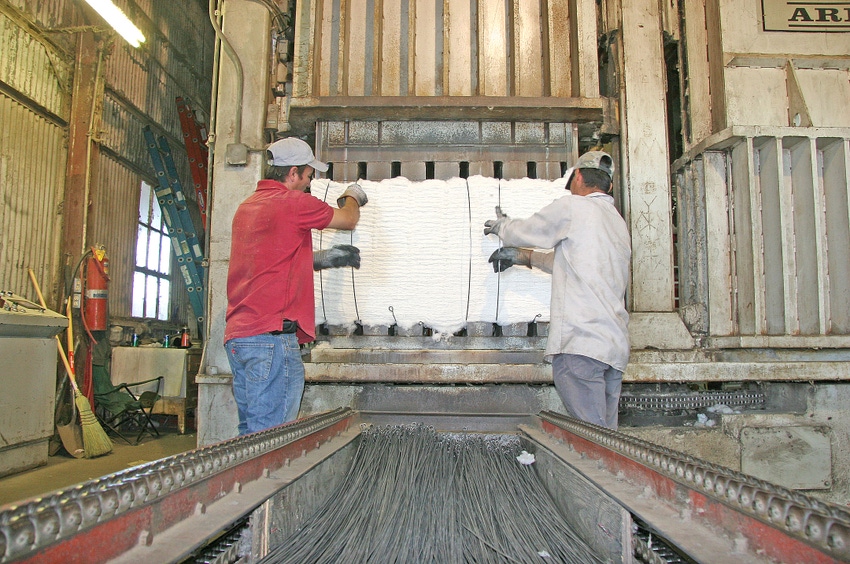
Strong demand should help support cotton prices
While O.A. Cleveland, Jr., says he’d “love to see” the 95 cents that some international analysts are forecasting for the December cotton contract, “I personally have difficulty going above the 86 cent level. There is some very strong resistance at 86-87 cents," the Mississippi State University Extension economics professor emeritus said at the annual commodity conference of the Mississippi Farm Bureau Federation.

The same conditions that took the cotton market to its highs in late January remain in place, says O. A. Cleveland, Jr., Mississippi State University Extension economics professor emeritus.
“The situation is exactly the same,” and should provide support for prices in the 80 cent range, he said at the annual commodity conference of the Mississippi Farm Bureau Federation.
And while he says he’d “love to see” the 95 cents that some international analysts are forecasting for the December contract, “I personally have difficulty going above the 86 cent level.

JIMMY WHITAKER, left, Satartia, Miss., and Farrell Boyd, manager of the Mississippi Boll Weevil Management Corp., were among those attending the annual commodity conference of the Mississippi Farm Bureau Federation.
“There is some very strong resistance at 86-87 cents. For the 2013 crop, 86 cents is a place where my price analysis starts to fail — I can’t see it going beyond that. I’d love to see 95 cents, but that’s too big a bite for me to take right now.”
With the outlook for significantly less cotton acreage in the U.S. this year, and particularly in Mississippi, Cleveland says production and consumption numbers are continually changing.
“I’m hearing 300,000 acres of cotton in Mississippi, and some are saying it could go as low as 275,000, even 200,000. We’ll certainly reduce acres in the Mid-South.
“The Southeast will decline by 30 percent to 35 percent. California may actually move up a bit, because Pima prices are higher due to huge purchases by China.
“Texas is always a huge wild card. In many cases, they don’t have another alternative. They’ve planted a lot of dryland wheat this year, and a lot of grain sorghum along the Coastal Bend. Nonetheless, they’ll have a huge cotton acreage and will use the insurance program.
“They won’t have the 8 million acres they’ve had in the past — perhaps only 6 million or less. But they’ll still have 55 percent to 60 percent of the acreage that will be planted in the U.S. this year, unless the drought there continues.
“Long range weather forecasters are saying Texas and the Southwest are looking at a long range drought. Folks I talk to out there say it’s still very dry — some say there’s not an ounce of water at 10-foot depth. A farmer I know who’s 70 years old says he hasn’t seen it this dry in his lifetime. We’ve got to assume the long range weather folks are correct and that the drought will continue out there.”
Most predictions are for 10.2-10.3 million acres in the U.S., Cleveland says, “but I’m a bit lower than that. I think Georgia will be very strong with their acreage this year, which will keep it a bit above 10 million acres. We could have a crop that ranges from as low as 12 million bales up to 14 million, depending on harvested acreage and yield.”
Unsettled conditions in two competing countries pose questions about world supply, Cleveland says.
“Pakistan, an important cotton country, is coping with a lot of political and religious unrest, and they’re going to have a smaller acreage. Mali, a cotton competitor for the U.S., is in a full scale war, so we don’t know the prospects for their cotton production. This is somewhat optimistic for world cotton prices, though.
“As late as the first of January, the USDA was saying we’d increase world carryover stocks by 11 million bales this year, up to 80-81 million. But I think carryover will by only 4 million to 5 million bales.
“I think we’re going to see considerably more consumption than the USDA is looking at. Also, I think we’ll see USDA make some major adjustments in its India numbers — there’s a lot less cotton there due to their monsoon failure, etc.”
Consumers in both the U.S. and China are feeling much better about their economic outlooks, Cleveland says. “In the U.S., consumers are back in retail outlets buying cotton goods and clothes. Sales of sporting goods and clothing at The Gap, Polo, Walmart, and other retailers are up 5 percent to 7 percent month on month. Cotton consumption is getting back to levels we like to see.
“I would anticipate we’ll increase consumption in the neighborhood of 10 million to12 million bales more than production in the next season. The huge carryover we have is going to all but be taken care of in 2013.”
Worldwide, current carryover is about 80 million bales, he says, “more than 48 million sitting in China’s reserves. But there isn’t much cotton outside of China — that’s one of the reasons the cotton price is increasing. Outside of China, the availability of cotton is very tight around the globe.
“They aren’t expected to release any of the cotton from their reserve, and they’re certainly not going to export it. They’ve been doing this for about two years, trying to keep the price of cotton high because they’re paying their growers so much. Everything they’ve been doing is to try and keep cotton prices high, and we assume that will continue to be their plan.
Heavy positions by speculative funds have also helped support cotton prices, Cleveland says.
“These large funds have been in this market at a level more than twice what they were in 2011 and 2012, and they’ve been taking excellent profits. Now, they’re returning to the cotton market and we’re back today (Jan. 29), very briefly, to 84 cents for March contract. We’re pushing 81 cents in December. The speculators will come back into the market because they see the opportunity to make more money.”
Asian textile mills are only partially covered for their cotton needs, Cleveland says.
“A survey of textile mills in Asia at the end of December showed that, with one exception, South Korea, they only had about 70 percent coverage for the first quarter of 2013. For April-June, more than half their needs were uncovered, and they were more than half uncovered in the third and fourth quarters. They need to begin to cover more of their needs for 2013 and on into 2014.
“Why did they wait so long to price their cotton this year? Because the last two years, it paid for them to wait. Historically textile mills just do what they did the previous year, if it worked. But it’s not working this year, and they’re having to pay to get the cotton they need.”
About the Author(s)
You May Also Like



